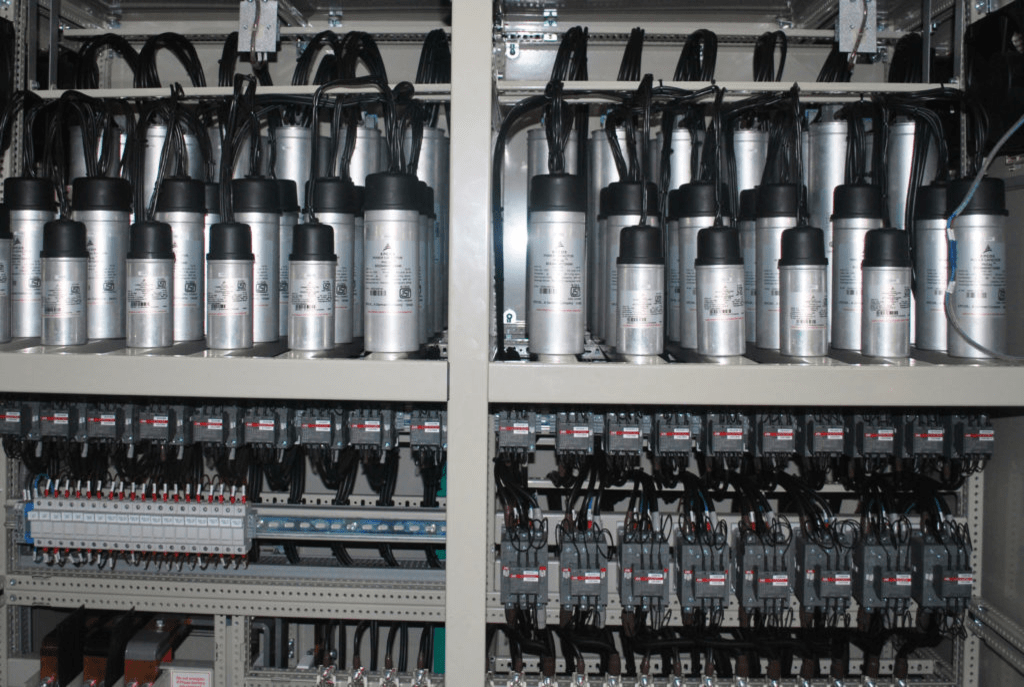There is a norm that since capacitor banks are static type electrical equipment, regular maintenance is not required. But capacitors need to be monitored and maintained regularly. The unawareness and the negligence of the users may leads to reduce the life expectancy or failures of the capacitors which would cause an ultimate loss for your investment.
During the design, assembling, installation, inspection and maintenance criterions relevant manufacturer standards and safety practices should be adhered. In this context the important practices of inspection and maintenance of Capacitor Bank is discussed.
Visual Inspection
This is the first and basic step of a maintenance procedure which is govern to find the condition and the status of the equipment for blown capacitor fuses, flashovers over the insulating materials, capacitor unit leaks, bulged cases, discolored cases, over pressure disconnections has operated and ruptured cases.
An infrared thermal camera will be useful for inspecting the hotspots for overheated joints, capacitors and surfaces while the capacitor bank is energized. These records can be maintained for future references.
Discharge the capacitors before do any maintenance work
As we all know, a capacitor is an electrical energy storage device. Hence even after de-energizing a capacitor, residual charges will be there. After a capacitor bank is de-energized at least 5-10 minutes should be waited before approaching it. With that it allows sufficient time for the capacitors to internally discharge through the resistors in each capacitor unit and the stored electrical energy will be dissipated through the resistor as heat. These discharging resistors are designed, when the supply voltage is switched off it will keep a 75V maximum voltage within 60 seconds.
Therefore, wait before approaching it to allow sufficient time for the internal discharge resistors in each capacitor unit to dissipate the stored energy.
How to check whether the discharging resistor is working?
- Power the capacitor up and down.
- After 60 seconds the voltage between the terminals must decline to less than 75V
Bulged capacitors and leaking capacitors should be removed
Under excessive high-voltage or high-current stressing, the capacitor may overheat or excessively arc. This generates gases that can cause the capacitor to bulge. As a capacitor eventually fails, it may eject molten dielectric film, or even small flames, through the sides or ends of the capacitor.
Due to the failures of the cans capacitors can cause leaking. When handling these capacitors avoid contact with the skin and take measures to prevent entry into sensitive areas such as eyes. Some of these liquids are combustible liquids and these should be handled with care.
Handling and disposal of capacitor insulating fluid should comply with local regulations and other health and safety measures.
Re-energizing buying nolvadex online in usa the best foods to the capacitors
Allow a minimum of 5 minutes between de-energization of the capacitor bank and re-energization of the capacitor bank to allow enough time for the stored energy to dissipate.
Inspection criterions carried out before energizing the capacitor bank
Check whether the mechanical assembly of the capacitor units is in line with the electrical code providing enough clearance and ventilation.
- Physical inspection and measurements should include loose connections, overheated lead wires, and faulty fuses. Fuses should be inspected carefully for evidence of overheating or other such damage.
- Check all the electrical connections specifically all the individual fuse connections whether they have a good electrical contact and all terminal connections are tightened properly.
- Make sure connection cables are of flexible type or flexible copper bands are used. This is mandatory to allow the overpressure disconnector work and avoid mechanical stress on the terminals and feedthroughs.
- Clean all insulators and fuses to prevent the possibility of creating a flashovers through them due the dust and dirt.
- Clean the louvers and change the dust filters of the louvers if requires.
- Earthing should be done at capacitors and reactors separately. The threaded bottom stud of the capacitor has to be used for grounding. In case grounding is done via metal chassis that the capacitor is mounted to, the layer of varnish beneath the washer and nut should be removed.
- Prior to energizing the bank, verify the capacitance values of each phase and compare them with the coordination values used in the relay settings.
- Periodic Inspections should be carried out and the frequency of the inspection should be determined by local conditions such as environmental factors and types of controllers such as anti-resonance switches (Thyristor Switches) or contact type switches.
- Take current reading twice a year and compare with nominal current. Use a Power analyzer or true effective RMS-meter and check the power factor with the analyzer and the APFC controller is the same. If there is a considerable deviation check whether the CT and voltage measuring inputs are connected as per the guideline and the right settings has been given.
Ex: Voltage Input: L1 & L2
Current input from CT: L3
- With the time capacitor dielectric materials are deteriorating and hence the capacitance and the available reactive power of the capacitor is getting reduced. By measuring the capacitance of the capacitance the available reactive power can be calculated as follows and it is very important to keep the measurements as benchmark data for future comparison.
For 3-phase delta connected capacitor

- If the pre-determined loads are changed and a significant increase in the amount of non-linear loads, a harmonic study should be carried out and if the harmonics in the system exceeds the standard limits de-tuned capacitor bank (reactors) must be installed.
Ex: As a norm if the non-linear loads > 50% total load, detuned reactors are considered
Useful life of the capacitors
Even the manufacturer has recommended certain useful life of the capacitors, that depends on several factors as follows
- Duration of overload
- Ambient temperature and the resulting case temperature
- Maximum rms current and the resulting case temperature




